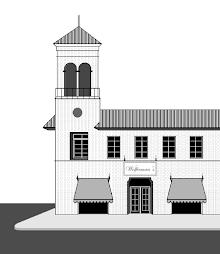14th Street West / US 41 and Cortez Road
Manatee County, Florida
The first mall-type shopping center in the Tampa Bay Area was built on a 23-acre tract, located 33.6 miles southwest of center city Tampa and 2.1 miles south of downtown Bradenton. The shopping center site was situated in an unincorporated section of Manatee County known as South Bradenton. CORTEZ PLAZA, a 3 million dollar complex, was developed by a joint venture of Yonkers, New York's Eastern Shopping Centers, Incorporated and Bradenton's Hardin Realty & Insurance.
Bradenton's Edward Dean Wyke designed the facility, with assistance from New York City's Lathrop Douglass. The single-level structure, which encompassed approximately 185,000 leasable square feet, was built from the ground up in only 7 months. Its open-air shopping concourse was covered by a series of concrete Hyperbolic Parabaloids, similar to those that would be used in Minnesota's APACHE PLAZA mall.
CORTEZ PLAZA was officially dedicated on February 12, 1959. Radio station WTRL broadcast live from their Studio-On-The-Mall. Dick Doty, who handled public relations for the shopping complex, acted as Master of Ceremonies. An invocation was given by Reverend Fred T. Kyle, Junior. Next came speeches by C. Van Ness Wood (president of Eastern Shopping Centers), E. Colin Lindsey (executive vice-president of Belk-Lindsey Stores) and State Senator Edward Price, Junior (R).
Entertainment was provided by Captain Hernan Cortez (actor Milt Collion, wearing Spanish conquistador regalia), four Cortez Plaza Charm Girls, The Dandee Clown and WSUN-TV's Captain Mac.
Other dignitaries attending the grand opening included H.B. Cunningham (vice-president of the Kresge Company), William Dempsey (senior vice-president of the Grand Union Company), Edwin N. Homer (executive director of Eastern Shopping Centers), A. Sterling Hall (Mayor of Bradenton) and Walter S. Hardin (president of Hardin Realty & Insurance). A ceremonial ribbon was cut and ten CORTEZ PLAZA stores and services opened for business.
These were Fremacs For Men, The Cotton Shop, Camera's Incorporated, Carter's Family Shoe Center, Mary Jane Shoes, Coach Butterfield Toy Store, Walter S. Hardin Realty & Insurance, a 1-level (40,000 square foot), Tampa-based Belk-Lindsey, 1-level (21,000 square foot) S.S. Kresge 5 & 10 and (24,800 square foot) Grand Union supermarket.
By June 1960,
the tenant list of twenty-seven stores and services included Walgreen
Drug, Lerner Shops, Gordon's Jewelers, Wash-O-Mat, Stauffer Slenderizing Salon and Rita's Beauty Shop. The Inter-City National Bank was built onto the south end of the mall. Two freestanding structures had also been constructed; Adventurers Cafeteria and the Cortez Lanes bowling alley.
Grand Union had been converted into a
Publix on November 3, 1959. This store was expanded by 1,800 square feet and thoroughly renovated. It re-opened on June 16, 1960. Belk-Lindsey grew into an adjacent store space and dedicated its new Store For Homes on December 4, 1959. Belk-Lindsey now encompassed 54,400 square feet.
In the mid-1960s, the first major mall addition was completed. The (33,200 square foot) CORTEZ SOUTH store strip was built on a pad adjacent to the Inter-City National Bank. Flowers & Foliage by Eiss welcomed first patrons on April 6, 1966. A Sears Catalog Store was dedicated on April 14th. Other CORTEZ SOUTH tenants included Cinderella Bootery, Luiz Maynard's Yarn Shop and the freestanding Bob's Pure Oil service station.
The second major addition was built east of Publix and implemented in two stages. The first consisted of a 1-level (116,000 square foot) Woolco discount mart. which opened on September 23, 1968. An entity known as Bradenton Associates developed the second stage. A two-building store strip, known as CORTEZ EAST, was added to the existing Woolco.
One of the first operational stores was Allied Radio Shack, which held its grand opening in October 1971. The Jerry Lewis Twin Cinema showed its first features on December 25, 1971. Other tenants included Fill-R-Up Systems, the Hallmark Store and Caravelle Ice Cream. The combined area of all CORTEZ EAST structures was approximately 174,300 leasable square feet. CORTEZ PLAZA and the two associated store strips now spanned approximately 392,500 leasable square feet.
The completion of DESOTO SQUARE MALL, in August 1973, cast a shadow over the older, open-air shopping hub. Built across Cortez Road, the fully-enclosed DESOTO SQUARE encompassed around 700,000 leasable
square feet and contained seventy-seven stores and services.
CORTEZ PLAZA was sold to Coral Gables-based First Capital Companies in January 1978. A 1.5 million dollar renovation commenced in July that would update the mall's so-called "frumpy appearance." The main structure and CORTEZ SOUTH strip were refurbished with Spanish-style stucco exteriors and a lighted belfry was built. Most of the original mid-century modern design elements were either removed or covered over.
Belk-Lindsey closed its CORTEZ PLAZA unit on June 15, 1979 and relocated to DESOTO SQUARE. Miami-based J. Byron assumed the vacant space and opened on September 11th of the same year. By this time, the mall had been reenvisaged as an "old world marketplace," with boutiques, push-cart vegetable and flower peddlers, strolling performers and magicians.
Stores and services in the new and improved CORTEZ PLAZA included Baskin-Robbins Ice Cream, Publix, S.S. Kresge, Ace Hardware, Helyn Browns ladies' wear, June's Hallmark Card & Gift Shop, Camp & Hike Shop, Fun Machine, Jontie Magic Shop, Old World Tobacconist and T-Shirt World. Unfortunately, by the mid-1980s, the newness had worn off of the much-ballyhooed mall reinvention. It had become obvious that CORTEZ PLAZA could not compete with DESOTO SQUARE, no matter what new repositioning and redecorating concept was followed.
The shuttering of J. Byron, in January 1986, sent CORTEZ PLAZA into a downward spiral. Tenants bailed, leaving the complex thirty-percent-leased. Dallas-based Vantage Companies bought the struggling shopping hub in June 1987. They initiated a wrecking ball renovation in October. During the 10 million dollar project, the main mall structure and Cortez Lanes building were demolished. The CORTEZ SOUTH structure was left standing. CORTEZ EAST was not officially part of the complex.
A 276,000 square foot -thirty-one store- power center was built, which retained CORTEZ PLAZA as its name. The complex was anchored by a 1-level (87,000 square foot) Zayre discount mart, which opened its doors on September 9, 1988. Other major tenants included a (42,100 square foot) Publix, dedicated on December 1, 1988, and (11,100 square foot) Walgreen Drug.
Inline stores included Little Professor Book Center, Women's Discount Fashions, Buzzard's Nest Records and Courtesy Cleaners. The fourth CORTEZ PLAZA anchor was a (32,500 square foot) Circuit City SuperStore, which welcomed first patrons on November 16, 1989. An complex-wide grand opening was held on November 24th.
Zayre had morphed into an Ames discount store in October 1989. This unit was shuttered in September 1990. Montgomery Ward opened in the space on March 4, 1991 and was shuttered in March 2001. Burlington Coat Factory assumed the space and was dedicated on October 1st. By December 2003, CORTEZ PLAZA had changed hands three times. Beachwood, Ohio-based Developers Diversified Realty purchased the property in February 2007.
An affiliate of Richmond, Virginia's Hackney Real Estate Partners assumed ownership of CORTEZ PLAZA in October 2018. At this time, there were twenty-four operational stores and services. These included Burlington, PetSmart, Shoe Carnival. Chuck E. Cheese and LA Fitness.
Sources:
The Bradenton Herald (Bradenton, Florida)
The Herald-Tribune (Bradenton, Florida)
The Tampa Bay Times
http://www.nreionline.com
http://www.inlandse.com (website on Internet Archive Wayback Machine)
www.simon.com
www.cinematreasures.org
http://www.nreionline.com
http://www.inlandse.com (website on Internet Archive Wayback Machine)
www.simon.com
www.cinematreasures.org
Manatee County Historical Records Library
"Belk" article on Wikipedia
FAIR USE OF CORTEZ PLAZA IMAGES:
The photos from the Manatee County Historical Records Library illustrate a key moment in
the mall's history that is described in the article. The images are not replaceable with free-use or public-domain
images. The use of the images does not limit the copyright owners'
rights to distribute the images in any way. The images are being used
for non-profit, informational purposes only and their use is not
believed to detract from the original images in any way.
BLACK AND WHITE PHOTOS:
From the Gottscho-Schleisner Collection / Repository: United States Library Of Congress Prints and Photograph Division, Washington, D.C. / Taken by Gottscho-Schleisner, Inc., November 1959 / Lathrop Douglass- Client / Photographs are in the public domain: no known restrictions on publication / www.loc.gov/rr/print/catalog.html
From the Gottscho-Schleisner Collection / Repository: United States Library Of Congress Prints and Photograph Division, Washington, D.C. / Taken by Gottscho-Schleisner, Inc., November 1959 / Lathrop Douglass- Client / Photographs are in the public domain: no known restrictions on publication / www.loc.gov/rr/print/catalog.html


